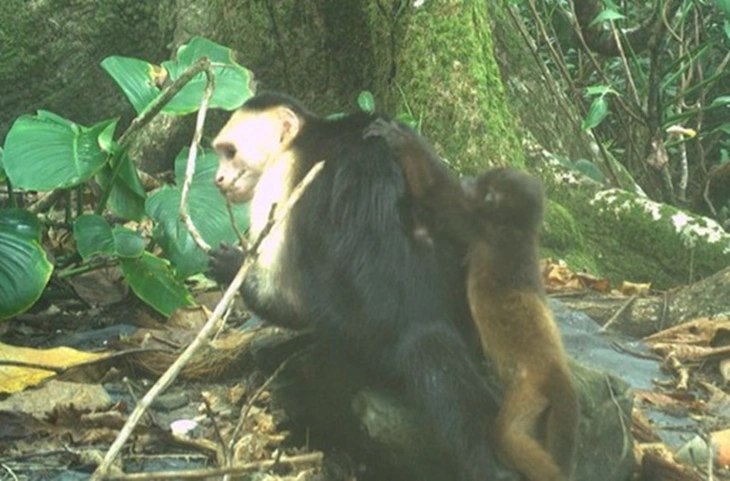A white-faced Capuchin monkey carries a baby howler monkey - Photo: MAX PLANCK INSTITUTE OF ANIMAL BEHAVIOR
White-faced capuchins (Cebus capucinus imitator) are the dominant species on the Jicaron Islands off the coast of Panama. They are an intelligent species with many interesting behaviors, such as using stone tools to forage for food in a way previously only known to humans.
Thanks to 15 months of camera trap data at a research site on Jicaron, a small island 55km off the coast of Panama and part of Coiba National Park, scientists discovered their strange behavior: kidnapping the babies of other monkey species.
According to ScienceAlert on May 20, behavioral ecologist Zoe Goldsborough, working at the Max Planck Institute for Animal Behavior (Germany), and her colleagues discovered that Capuchin monkeys kidnapped the babies of howler monkeys (Aloutta palliata coibensis) and carried them everywhere.
After observing and decoding the above kidnapping behavior, the group concluded that this was a new "fashion" of Capuchin monkeys.
"Scientists are continuing to explore whether this is a cultural trend in this species. A behavior is considered a cultural trend if it spreads among individuals in a group," said Ms Goldsborough.
The team first noticed the anomaly in the Capuchin monkey troop through a monkey named Joker. The team noticed that Joker was carrying a baby howler monkey on his back. After synthesizing the images, the team discovered that Joker had carried four different baby howler monkeys at different times.
A few months later, the behavior recurred and the team noticed that other Capuchins were following Joker’s lead. Over 15 months of observation, the team found that five Capuchins (including Joker) had carried 11 different baby howler monkeys.
At first, the researchers were puzzled by the Capuchin monkeys’ strange behavior, thinking that they might be adopting the howler monkeys’ young. However, fostering the young of another species is rare and usually done by females, and all five Capuchins were males.
They also did not seem to care for the baby howlers. The team confirmed that four baby howlers had died and they assumed that the remaining seven had also starved to death on the Capuchin's back.
"I think they want to keep howler monkeys around not because they care for them but as an 'accessory'," said Ms Goldsborough.
The team plans to continue studying the behavior to see if it evolves into something else or if new trends emerge. They also want to learn how howler monkeys react to having their babies taken away.
The study was published in the journal Current Biology.
Fads are not usually found in non-human animals. Scientists have previously observed a trend of wearing “salmon hats” among killer whales and a trend of putting grass in the ears of chimpanzees in Zambia.
ANH THU
Source: https://tuoitre.vn/loai-khi-thong-minh-bong-thich-bat-coc-con-loai-khi-khac-chuyen-gi-xay-ra-20250521135549111.htm




































































































Comment (0)